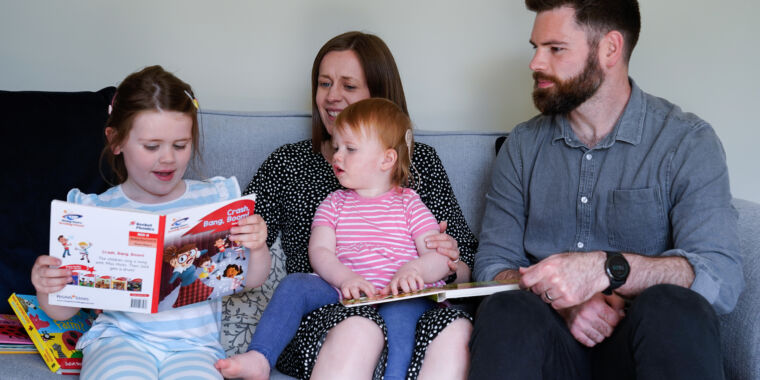More children gain hearing as gene therapy for profound deafness advances
Success —
The therapy treats a rare type of deafness, but experts hope it’s a “jumping point.”

Enlarge / Opal Sandy (center), who was born completely deaf because of a rare genetic condition, can now hear unaided for the first time after receiving gene therapy at 11-months-old. She is shown with her mother, father, and sister at their home in Eynsham, Oxfordshire, on May 7, 2024.
There are few things more heartwarming than videos of children with deafness gaining the ability to hear, showing them happily turning their heads at the sound of their parents’ voices and joyfully bobbing to newly discovered music. Thanks to recent advances in gene therapy, more kids are getting those sweet and triumphant moments—with no hearing aids or cochlear implants needed.
At the annual conference of the American Society for Gene & Cell Therapy held in Baltimore this week, researchers showed many of those videos to their audiences of experts. On Wednesday, Larry Lustig, an otolaryngologist at Columbia University, presented clinical trial data of two children with profound deafness—the most severe type of deafness—who are now able to hear at normal levels after receiving an experimental gene therapy. One of the children was 11 months old at the time of the treatment, marking her as the youngest child in the world to date to receive gene therapy for genetic deafness.
On Thursday, Yilai Shu, an otolaryngologist at Fudan University in Shanghai, provided a one-year progress report on six children who were treated in the first in-human trial of gene therapy for genetic therapy. Five of the six had their hearing restored.
That trial, like the one Lustig presented, involved treating just one ear in all of the children—a safety precaution for such early trials. But Shu and colleagues have already moved on to both ears, or bilateral treatment. After presenting a progress report on the first trial, Shu presented unpublished early data on five additional patients who participated in the first in-human trial of bilateral treatment. All had bilateral hearing restoration and speech perception improvement.
“The opportunity of providing the full complexity and spectrum of sound in children born with profound genetic deafness is a phenomenon I did not expect to see in my lifetime,” Lustig said in a statement.
Jumping point
Shu and Lustig’s trials are separate but the treatments are, in broad strokes, similar. Both are aimed at restoring hearing loss caused by mutations in the OTOF gene the codes for the protein otoferlin. Normally, otoferlin is a critical protein for transmitting sound signals to the brain, specifically playing a key role in synaptic transmission between the ear’s inner hair cells and the auditory nerve. Using gutted adeno-associated viruses as vectors for gene delivery, the therapies provide the inner ear with a functional version of the OTOF gene. Once in the ear, the gene can be translated into functional otoferlin, restoring auditory signaling.
In the trial Lustig presented, the two patients saw a gradual improvement of hearing as otoferlin protein built up after treatment. For the 11-month-old, normal levels of hearing were restored within 24 weeks of treatment. For the second patient, a 4-year-old, improvements were detected at a six-week assessment. In the trial Shu presented, children began seeing hearing improvements at three- and four-week assessments. The children will continue to be followed into the future, which holds some uncertainties. It’s unclear if they will, at some point in their lives, need additional treatments to sustain their hearing. In mice, at least, the treatment lasts for the duration of the animals’ lives—but they only live for a few years.
“We expect this to last a long time,” Lustig said Wednesday. But “we don’t know what’s going to happen and we don’t know whether we can do a second dose. But, probably, I would guess, at some point that would have to be done.”
For now, the treatment is considered low-hanging fruit for the burgeoning field of gene therapy since it targets a severe condition caused by recessive mutations in a single gene. Otoferlin mutations lead to a very specific type of deafness called auditory neuropathy, in which the ear fails to send signals to the brain but works perfectly fine otherwise. This is an ultra-rare form of deafness affecting 1–8 percent of people with deafness globally. Only about 30 to 50 people in the US are born with this type of deafness each year.
However, Lustig calls it a “jumping point.” Now that researchers have shown that this gene therapy can work, “This is going to really spark, we hope, the development of gene therapy for more common types of deafness,” he said.
More children gain hearing as gene therapy for profound deafness advances Read More »
